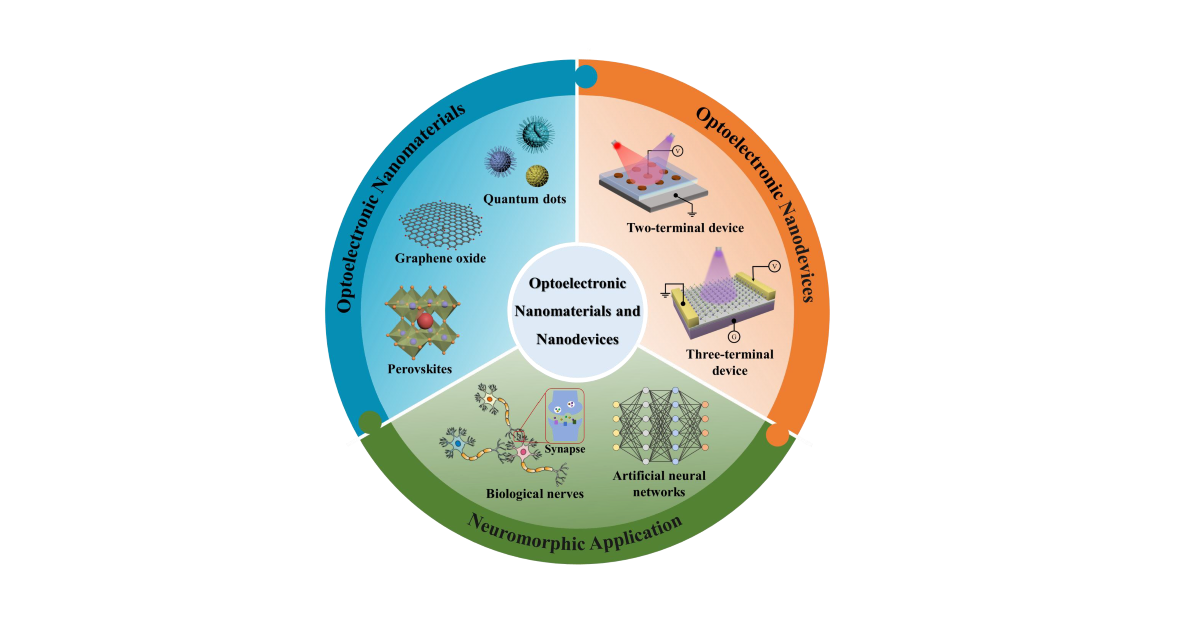- 4.3Impact Factor
- 9.2CiteScore
- 16 daysTime to First Decision
Optoelectronic Nanomaterials and Nanodevices for Neuromorphic Application
This special issue belongs to the section “Nanophotonics Materials and Devices“.
Special Issue Information
Dear Colleagues,
Inspired by the biological system, the development of neuromorphic visual systems is at the cutting-edge of research, showing great promise for applications in neuromorphic intelligence technologies and smart robotics. Optoelectronic nanomaterials, including quantum dots, 2D materials, perovskites, and nanowires, and optoelectronic nanodevices have emerged as a promising candidate for artificial synapses in the construction of neuromorphic visual systems. Their novel optical and photophysical properties allow them to closely resemble biological functions.
This Special Issue focuses on the development of emerging optoelectroinc nanomaterials, the design of fucntional nandevices, and the exploration of neuromorphic applications. Original research articles, reviews, and perspectives are welcome. Research areas may include (but are not limited to) the following: microstructure design of optoelectronic nanomaterials; manufacture of optoelectronic nanodevices mainly including memristors, photosensors, phototransistors, and other optoelectronic synaptic devices; neuromorphic applications in artificial synapses/neurons; and artificial visual systems.
We look forward to receiving your contributions.
Dr. Ya Lin
Guest Editor
Manuscript Submission Information
Manuscripts should be submitted online at www.mdpi.com by registering and logging in to this website. Once you are registered, click here to go to the submission form. Manuscripts can be submitted until the deadline. All submissions that pass pre-check are peer-reviewed. Accepted papers will be published continuously in the journal (as soon as accepted) and will be listed together on the special issue website. Research articles, review articles as well as short communications are invited. For planned papers, a title and short abstract (about 250 words) can be sent to the Editorial Office for assessment.
Submitted manuscripts should not have been published previously, nor be under consideration for publication elsewhere (except conference proceedings papers). All manuscripts are thoroughly refereed through a single-blind peer-review process. A guide for authors and other relevant information for submission of manuscripts is available on the Instructions for Authors page. Nanomaterials is an international peer-reviewed open access semimonthly journal published by MDPI.
Please visit the Instructions for Authors page before submitting a manuscript. The Article Processing Charge (APC) for publication in this open access journal is 2400 CHF (Swiss Francs). Submitted papers should be well formatted and use good English. Authors may use MDPI's English editing service prior to publication or during author revisions.
Keywords
- nanomaterials and nanodevices
- memristor
- photosensor
- phototransistor
- optoelectronic synaptic devices
- neuromorphic system
- artificial vision
- sensory functions

Benefits of Publishing in a Special Issue
- Ease of navigation: Grouping papers by topic helps scholars navigate broad scope journals more efficiently.
- Greater discoverability: Special Issues support the reach and impact of scientific research. Articles in Special Issues are more discoverable and cited more frequently.
- Expansion of research network: Special Issues facilitate connections among authors, fostering scientific collaborations.
- External promotion: Articles in Special Issues are often promoted through the journal's social media, increasing their visibility.
- e-Book format: Special Issues with more than 10 articles can be published as dedicated e-books, ensuring wide and rapid dissemination.

